Guide to the Parks Canada Process under the Impact Assessment Act
Table of contents
- 1.0 Introduction
- 2.0 Integration of IA into project planning
- 2.1 Development and submission of a project description
- 2.2 Review of the project description
- 2.3 Selection of the appropriate IA pathway
- 2.4 Preparation of an IA
- 2.5 Review of the IA and determination of the significance of residual adverse environmental effects
- 2.6 Parks Canada decision on the project proposal
- 2.7 Project implementation and follow-up
- 3.0 Additional considerations
- 3.1 Indigenous engagement and consultation
- 3.2 Public and stakeholder engagement
- 3.3 Species at Risk Act considerations
- 3.4 Additional legislative requirements
- 3.5 UNESCO World Heritage Sites
- 3.6 Working with other federal authorities
- 3.7 Changes to a previously assessed project
- 4.0 Tools and resources
- Appendix 1 — Guidance for the application of the Detailed Impact Assessment (DIA) pathway
Figures
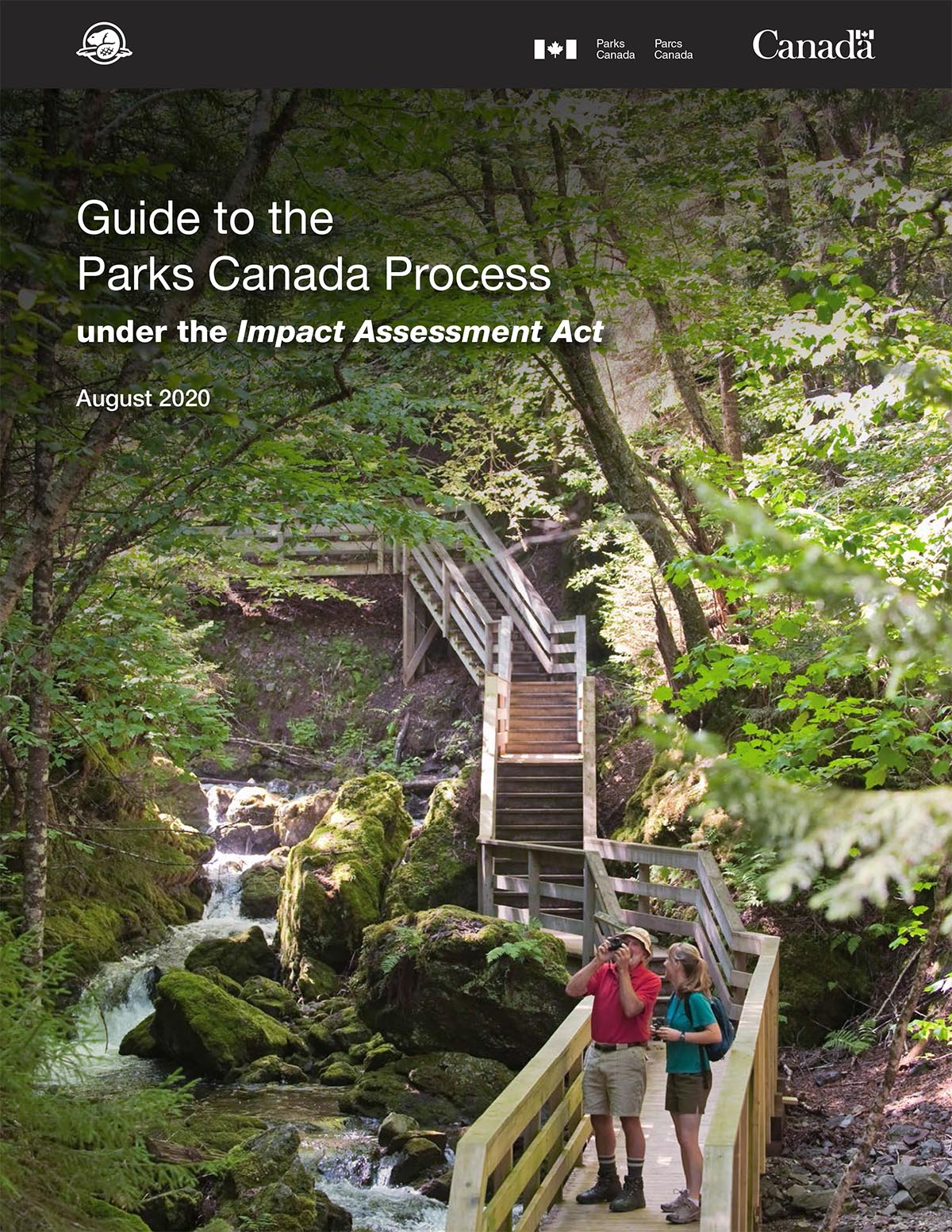
Guide to the Parks Canada Process under the Impact Assessment Act
- Catalogue Number: R62-571/2020E-PDF
- ISBN: 978-0-660-36985-3
Front cover image credits
Cover photo: Fundy National Park © Park Canada
- Approved by:
- Darlene Upton, Vice-President, Protected Areas Establishment and Conservation, Parks Canada
- Signed on:
- August 3, 2020
- Contact:
- pc.evaluationsenvironnementale-environmentalassessment.pc@canada.ca or the Manager, Impact Assessment Division, Natural Resource Management Branch, Parks Canada
Note: This guide may be subject to modification from time to time in order to reflect changes in legislation or policy or to improve the practice of impact assessment. Users of the Guide should consult with Parks Canada representatives to ensure that they are using the most up-to-date version.
1.0 Introduction
This guide describes the impact assessment (IA) process developed by Parks Canada to fulfill its requirements as a federal authority under the Impact Assessment Act (IAA) Footnote 1 as well as its legal and mandated obligations to protect Canada’s natural and cultural heritage. The purpose of this guide is to provide external proponents, stakeholders, partners, Indigenous peoples and the public with an understanding of what Parks Canada’s impact assessment requirements are for project proposals within a Parks Canada protected heritage place Footnote 2.
IA is an important means for Parks Canada to:
- meet its obligation under the IAA to determine if carrying out a project is likely to cause significant adverse environmental effects;
- systematically, efficiently and pro-actively evaluate projects within protected heritage places to ensure they are as well designed as possible to avoid or reduce adverse effects; and
- achieve the Agency’s mandate to protect and present nationally significant examples of Canada’s natural and cultural heritage, and foster public understanding, appreciation and enjoyment in ways that ensure the ecological and commemorative integrity and ecological sustainability of these places for present and future generations.
1.1 Parks Canada’s approach to IA
The Parks Canada Directive on Impact Assessment (2019) outlines the legislative and policy requirements and accountabilities for assessing the impacts of proposed projects within Parks Canada protected heritage places. The Directive outlines nine principles that guide impact assessment at Parks Canada:
- Mandate-oriented: Impact assessment undertaken by or for Parks Canada will focus on the Parks Canada mandate using an integrated approach that involves functional specialists, managers and engages Indigenous cooperative management structures, as appropriate.
- Early initiation and integration: Impact assessment requirements will be integrated into planning processes as early as possible and used to meet other legal requirements.
- Flexibility: Parks Canada will apply a variety of impact assessment methods to achieve effective and efficient analysis, adapting to meet the needs of specific circumstances when appropriate, in keeping with requirements under impact assessment legislation, including land claim agreements, and the Parks Canada process under IAA.
- Focused and appropriate effort: The scope, level of effort, and detail of an impact assessment will reflect the risk and likelihood of significant adverse environmental effects and the importance of the affected resources, so as to focus on issues most relevant to the achievement of Parks Canada’s mandate, to the extent that relevant legislation, including land claim agreements, afford.
- Evidence-based: The analysis of potential adverse environmental effects of a project will be based on evidence, including science and Indigenous knowledge, available within resource constraints, and will acknowledge uncertainty and limitations.
- Inclusiveness: Interested parties will be offered, as appropriate, an opportunity to participate in the impact assessment process, in keeping with, or in addition to, requirements under relevant legislation, including land claim agreements.
- Meaningful engagement: Engagement activities undertaken through an impact assessment process will be focused on potential adverse environmental effects of a proposed project. The type of engagement undertaken will vary from project to project and will be proportionate to the interest in potential adverse environmental effects, as well as the risk and likelihood of significant adverse environmental effects.
- Transparency: Transparency will be pursued by notifying the public and stakeholders of impact assessment processes, making documents available and providing rationale for decisions as appropriate.
- Meaningful participation of Indigenous peoples: Participation of Indigenous peoples in the impact assessment process will reflect rights and interests, and demonstrate that Indigenous knowledge is taken into account when provided.
Under the IAA (section 82), Parks Canada’s legal accountability is to ensure that no project on the lands and waters it manages receives Parks Canada authorization or funding unless a determination is made that carrying out the project is not likely to cause significant adverse environmental effects. The Act provides discretion regarding how to conduct an assessment to determine whether or not a project is likely to cause significant adverse environmental effects. The Parks Canada Directive on Impact Assessment provides direction for the process Parks Canada will apply. In keeping with its mandated priorities, Footnote 3 Parks Canada’s IA process examines how a project may lead to adverse effects on:
- Natural resources – including species at risk, air, ground and surface water, soils, habitat features, as well as plants and animals found in the vicinity of a project or otherwise potentially affected by it;
- Cultural resources – including potential adverse effects on heritage value and character defining elements of known cultural resources, and risks to areas with high potential to contain cultural resources where no inventory has yet been completed;
- Visitor experience – potential adverse effects on key visitor experience objectives (how the proposal is anticipated to affect activities and/or visitors’ enjoyment and connection to place, in relation to defined objectives for the protected heritage place); and,
- The rights of Indigenous peoples. Footnote 4
In addition, the Parks Canada IA process requires consideration of potential indirect effects of a proposed project; specifically, how the effects of a proposed project on natural resources may in turn cause:
- adverse effects on health, social or economic conditions; and,
- adverse effects on Indigenous people, including their physical and cultural heritage, current use of lands and resources for traditional purposes, or any structure site or thing that is of historical, archaeological, paleontological or architectural significance.
Collectively, these types of impacts are referred to throughout this document as “environmental effects” or simply as “effects”.

1.2 Is an IA required?
One of the objectives of Parks Canada’s IA process is to ensure project review is conducted efficiently and that effort is focused on projects with the greatest potential for adverse environmental effects. This is accomplished through the selection of an appropriate IA pathway, as the depth of analysis varies with each pathway, enabling alignment with the risk and likelihood of the project causing significant adverse environmental effects.
Determination of the need for an IA and selection of the appropriate pathway is based on review of the project description.
- If Parks Canada determines that there are no potential adverse environmental effects from a proposed project, no IA will be required.
- If there is potential for adverse effects, Parks Canada will evaluate which IA pathway is appropriate.
This initial analysis of the requirement for an IA is documented in a standard template which is approved by the Field Unit Superintendent (known as Director of a Waterway in some locations), and provided to the proponent.
1.3 IA pathways
The IA process includes five impact assessment pathways. Selection of an appropriate IA pathway is based on the nature of the project’s interactions with the environment (i.e. the complexity of the interactions) and the project’s potential for significant adverse environmental effects (i.e. the level of environmental risk posed by the project) Footnote 5. The five pathways are:
- Preapproved Routine Impact Assessment (PRIA)
- Basic Impact Assessment (BIA)
- Detailed Impact Assessment (DIA)
- Alternate Process
- Designated Project
The five pathways are described in detail in Section 2.3 and the process used to determine the pathway is illustrated in Figure 1.
2.0 Integration of IA into project planning
IA work generally follows a sequence of predictable and methodical steps that should be integrated with the overall planning of a project proposal. Since the granting of authorizations to implement Footnote 6 a project will not occur until the IA has been completed, approved, and the results taken into account in authorization decision-making, it is important to gain a clear understanding of the IA process, including any engagement, consultation and permitting requirements, in order to develop a realistic project timeline and avoid unnecessary surprises and delays. IA work may also extend to follow-up requirements for approved projects. Additional detail on each of the following key steps is provided in subsequent sections.
- Development and submission of a project description
- Review of the project description
- Selection of the appropriate IA pathway
- Preparation of the IA
- Review of the IA and determination of the significance of effects
- Parks Canada decision on the project proposal
- Project implementation and follow-up
Information on the Parks Canada IA process is also available from Parks Canada Impact Assessment Practitioners. They can discuss the IA requirements, answer questions and identify other review and permitting requirements that may be associated with a project proposal. Information on related legislative requirements under the Species at Risk Act, the Fisheries Act, the Canadian Navigable Waters Act, and the Migratory Birds Convention Act, 1994 is provided in Section 3.
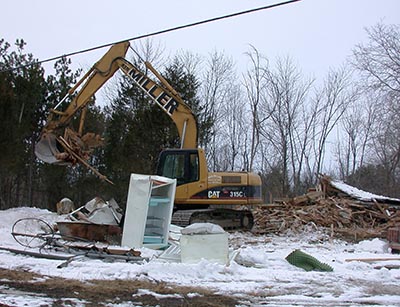
2.1 Development and submission of a project description
The provision of a detailed project description by the proponent is the first step to having a proposed project considered by Parks Canada. It is used by Parks Canada to evaluate if the project is acceptable from a legal and policy perspective and if so, whether an IA is required and which IA pathway should be applied.
Submission of good quality project description information will facilitate and streamline the review of a project proposal. It is also work that can be incorporated directly into any IA report that may be required.
Proponents are advised to contact Parks Canada staff from the protected heritage place where the project is proposed before commencing a project description, to confirm site-specific requirements. In general, a project description should provide a summary of the “who, what, where, when, why, how” of a proposed project: i.e. who is proposing and undertaking the work; what the project consists of; where the project will be sited (along with a description of natural and cultural resources and the adjacent built environment); when the project will be undertaken; why it is being undertaken, and how it will be carried out.
2.2 Review of the project description
Parks Canada will review submitted project descriptions for consistency with Parks Canada management objectives and requirements. This may include review by Parks Canada specialists in realty, planning, architecture, cultural resource management, Indigenous affairs and impact assessment. This initial review is conducted to identify any potential conflicts with legislation, Parks Canada policies and plans, management objectives, potential issues (such as cause for public concern), and to ensure the level of information is sufficient to facilitate the completion of an IA.
Incomplete project descriptions or those with insufficient detail will be returned to the proponent with an overview of deficiencies to be addressed.
2.3 Selection of the appropriate IA pathway
Each proposed project will be evaluated by Parks Canada to determine its potential to cause adverse environmental effects. As shown in Figure 1, no IA is required if initial review of the project description by Parks Canada determines:
- the proposed work is in relation to national security or an emergency situation as defined by the IAA (S.91); or
- the same proposal Footnote 7 was previously assessed in sufficient detail. In this scenario, Parks Canada would conduct an internal review and confirm with the proponent whether the previous assessment is adequate and applicable; or
- the proposal is NOT likely to cause adverse effects to natural or cultural resources that require mitigation, AND there is no uncertainty or need for further investigation regarding the potential for adverse effects.
If a proposed project is considered to have potential adverse environmental effects, an IA will be required and the IA pathway that is the most appropriate to address the potential effects will be determined by Parks Canada.
The Decision Framework for Proposed Projects Under the Impact Assessment Act (Figure 1) and associated criteria (Appendix 1) will guide selection of the most appropriate IA pathway in the context of the proposed project and site-specific circumstances. The Field Unit Superintendent will approve this selection.
Figure 1 — Decision framework for proposed projects under the Impact Assessment Act
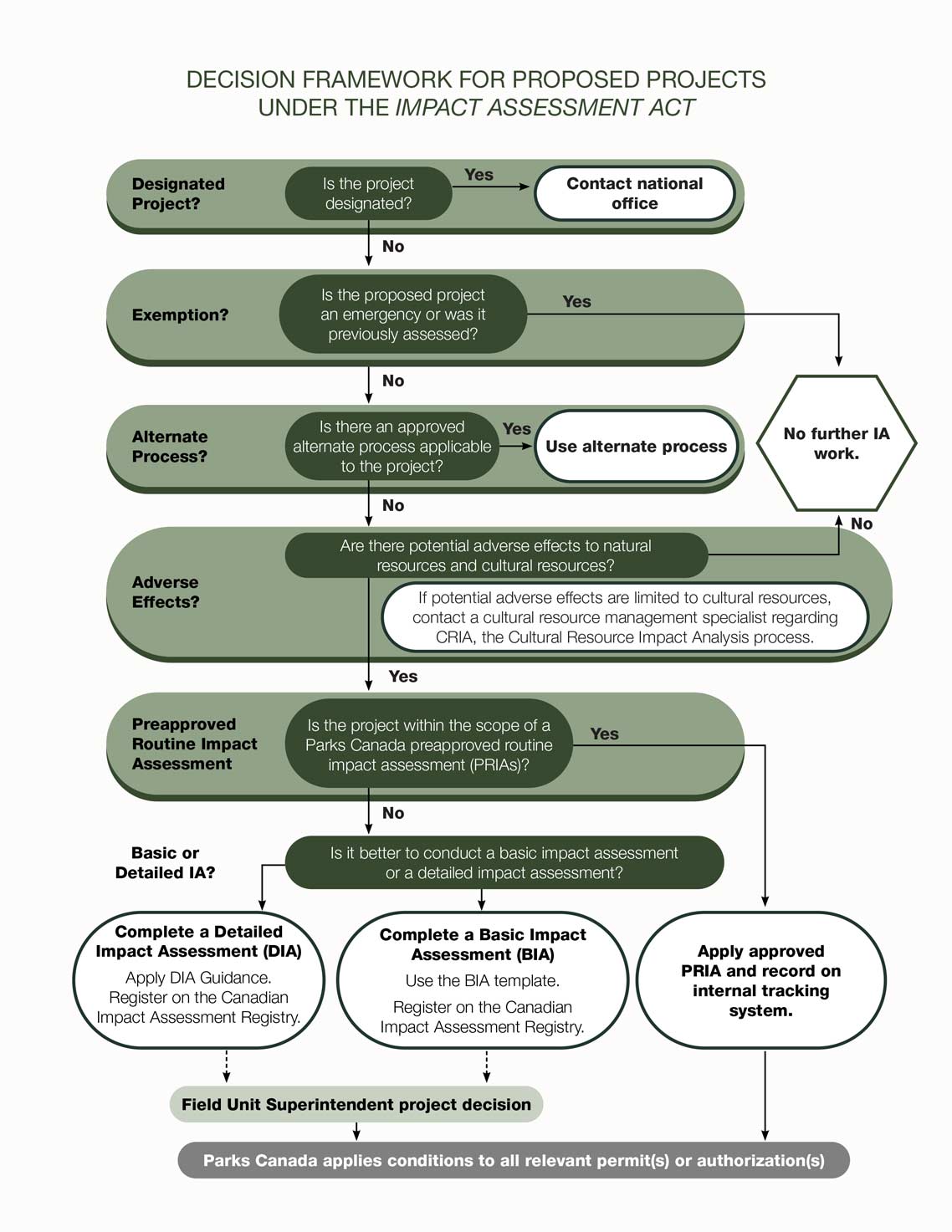
Decision framework for proposed projects under the Impact Assessment Act — Text version
Figure 1 — Decision framework for proposed projects under the Impact Assessment Act
- Is the project designated?
- Yes: Contact national office
- No: Is the proposed project an emergency or was it previously assessed?
- Is the proposed project an emergency or was it previously assessed?
- Yes: No further IA work required
- No: Is there an approved alternate process applicable to the project?
- Is there an approved alternate process applicable to the project?
- Yes: Use alternate process
- No: Are there potential adverse effects to natural resources and cultural resources?
- Are there potential adverse effects to natural resources and cultural resources?
- No: No further IA work required
- Yes: Is the project within the scope of a Parks Canada preapproved routine impact assessment (PRIAs)?
- If potential adverse effects are limited to cultural resources, contact a cultural resource management specialist regarding CRIA, the Cultural Resource Impact Analysis process.
- Is the project within the scope of a Parks Canada preapproved routine impact assessment (PRIAs)?
- Yes: Apply approved PRIA and record on internal tracking system
- Parks Canada applies conditions to all relevant permit(s) or authorization(s)
- No: Is it better to conduct a basic impact assessment or a detailed impact assessment?
- Yes: Apply approved PRIA and record on internal tracking system
- Is it better to conduct a detailed impact assessment?
- Complete a Detailed Impact Assessment (DIA)
- Apply DIA Guidance
- Register on the Canadian Impact Assessment Registry
- Field Unit Superintendent Project Decision
- Parks Canada applies conditions to all relevant permit(s) or authorization(s)
- Complete a Detailed Impact Assessment (DIA)
- Is it better to conduct a basic impact assessment?
- Complete a Basic Impact Assessment (BIA)
- Use the BIA template.
- Register on the Canadian Impact Assessment Registry.
- Field Unit Superintendent Project Decision
- Parks Canada applies conditions to all relevant permit(s) or authorization(s)
- Complete a Basic Impact Assessment (BIA)
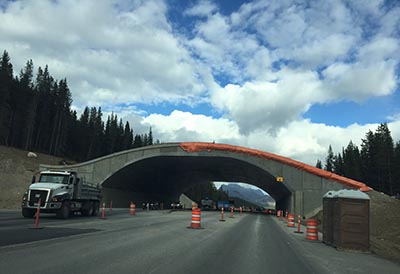
2.3.1 Preapproved Routine Impact Assessment (PRIA)
Parks Canada has identified classes of routine, repetitive projects with well understood and predictable effects. To maximize efficiency for these recurring projects, local and national scale PRIAs are developed and approved. These consist of suites of environmental management and mitigation measures for the defined classes of projects. Applying a PRIA is the appropriate IA pathway when the potential environmental effects of a proposed project can be fully addressed through one or more PRIAs and no additional IA is required. Footnote 8
National PRIAs are available on the internet and Parks Canada welcomes comments on these at any time. Projects assessed via the PRIA pathway are not included on the Canadian Impact Assessment Registry and the 30 day public notification period does not apply. Projects with elements or potential impacts outside of the scope of an approved PRIA are not eligible for this pathway.
Approved PRIAs addressing only some of the potential adverse effects associated with a project can be applied to streamline assessment and mitigation within another pathway (i.e. an approved Alternate Process, Basic Impact Assessment, or Detailed Impact Assessment).
Parks Canada will advise proponents of any PRIA s that may be applied to a proposed project along with any project-specific clarifications or additions.
2.3.2 Basic Impact Assessment (BIA)
A BIA is the appropriate level of review for projects where:
- the adverse effects are predictable and well understood;
- the adverse effects will be confined to the project site or immediate surroundings; and
- mitigation measures and impact management techniques are familiar.
A BIA is conducted using a standard Parks Canada template that enables an IA Practitioner to lay out how a proposed project will interact with the environment, particularly with valued components Footnote 9 such as specific natural or cultural resources. For projects subject to a BIA, Parks Canada will provide the template, identify any PRIA s that may be applied as part of the assessment, and provide other site and project-specific direction needed to complete the BIA. The level of detail in a BIA will vary dependent on the level of complexity and risk posed by the project. Generally, projects assigned to this pathway do not generate significant concern from public and stakeholders in relation to potential effects of the project proposal. The participation of Indigenous peoples in the impact assessment process will respect and reflect their rights and interests, and Indigenous knowledge provided through the process will be taken into account.
Parks Canada must post notification of a BIA on the Canadian Impact Assessment Registry for a minimum of 30 days, commencing with the project assessment pathway decision and the initial Canadian Impact Assessment Registry posting. Project proposals cannot be approved before the completion of this notification period. Proponents are encouraged to provide Parks Canada with adequate project description information in support of a pathway decision as soon as it is feasible to facilitate this legislative requirement.

2.3.3 Detailed Impact Assessment (DIA)
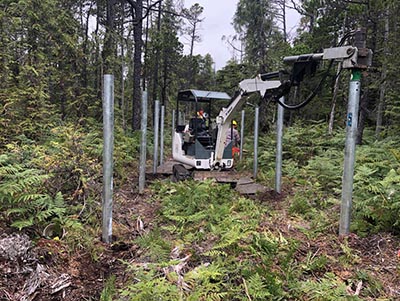
A DIA is Parks Canada’s most comprehensive level of assessment and is intended for projects where one or more project elements is complex based on the criteria found in Appendix 1. In general, DIAs are appropriate for projects for which:
- an in-depth analysis of project interactions with valued components is required;
- a particularly sensitive environmental setting may be affected; or
- a particularly sensitive valued component may be threatened.
Because the issues for these projects are complex, a DIA may necessitate the evaluation of alternatives or a follow-up monitoring program. Footnote 10 These projects may also generate significant interest or controversy related to potential adverse effects on natural or cultural resources, or components of the environment critical to key visitor experience objectives. A DIA therefore requires more thorough public participation related to the potential for the project to cause adverse environmental effects. The participation of Indigenous peoples in the impact assessment process will respect and reflect their rights and interests, and Indigenous knowledge provided through the process will be taken into account. DIAs require that the public, stakeholders, and Indigenous peoples have an opportunity to review and comment on the draft DIA. The opportunity to review the DIA draft terms of reference may also be considered, at the discretion of the Field Unit Superintendent. Notice of the DIA must be posted on the Canadian Impact Assessment Registry and will include the following additional information in both French and English:
- a project summary;
- an overview of the valued components to be assessed
- an outline of planned review, engagement and consultation opportunities that will be available; and,
- information regarding how to obtain a draft of the DIA
The level of detail in a DIA and the type of engagement and consultation undertaken will vary from project to project and will be proportionate to the risk and likelihood of the project leading to significant adverse effects. Additional information on the DIA process is found in Appendix 1 as well as in the Parks Canada Detailed Impact Assessment Handbook 2020 Draft., available from Parks Canada.
2.3.4 Alternate process
In certain cases, a proposal may be subject to a Parks Canada planning or permitting process other than IA. If Parks Canada has approved this additional process as providing an integrated means of meeting the legal requirements of the IAA and S.35 Indigenous Duty to Consult,Footnote 11 then a separate IA is not required. Parks Canada will advise a proponent of any such process and of its requirements in the event this pathway can be applied. Please consult a Parks Canada Impact Assessment Practitioner for more information.
2.3.5 Designated Project
Project types listed on the Physical Activities Regulations (considered designated projects) require an assessment by the Impact Assessment Agency of Canada with the participation of Parks Canada.
Note that this guide is intended to support the fulfillment of Parks Canada’s requirements as a federal authority under the IAA, and that the IA of designated projects will differ from the processes described herein. Proponents considering designated project proposals must consult with the applicable Parks Canada Field Unit Superintendent, the Parks Canada National Manager of Impact Assessment, and the Impact Assessment Agency of Canada.
2.4 Preparation of an IA
Impact assessments must be prepared by the proponent in accordance with guidance related to the IA pathway selected for the project and any other specifications identified by Parks Canada.
For projects addressed through application of one or more PRIAs, Parks Canada will provide the proponent with the PRIAs, and any additions or clarifications regarding their use. The proponent must apply the PRIAs in accordance with their conditions and any other requirements specified in relevant Parks Canada permits or authorizations. No additional IA is required, provided all effects are addressed by the PRIAs.
More detailed information on the BIA and DIA pathways is available from Parks Canada. Project-specific direction may also be provided by Parks Canada specialists for any of the IA pathways. Parks Canada may request or require the proponent to seek the involvement of stakeholders, the public, and Indigenous peoples when developing this direction at its discretion and in a manner appropriate for the selected pathway. In particular, Parks Canada and proponents will work with interested Indigenous knowledge holders in accordance with best practices to ensure the respectful collection and inclusion of Indigenous knowledge in the impact assessment.
Communications with Parks Canada staff early in the project planning phase is necessary to accommodate early integration of IA requirements, including posting of notices of BIAs and DIAs on the Canadian Impact Assessment Registry.
2.5 Review of the IA and determination of the significance of residual adverse environmental effects
Once a draft IA that meets Parks Canada’s requirements has been prepared, it is submitted for review. The process for review will depend on the IA pathway, the types of issues and the interest from the public, stakeholders and Indigenous groups. For BIAs and DIAs, revisions to multiple drafts may be required before the final draft is submitted to the Field Unit Superintendent for decision.
2.6 Parks Canada decision on the project proposal
A Parks Canada Impact Assessment Practitioner will evaluate and recommend, in accordance with the legal obligation under the IAA, whether the project is likely to cause significant adverse environmental effects.
- This step does not apply to projects fully addressed through PRIAs, as Parks Canada’s decision to apply the PRIA pathway reflects a determination that the project proposal will result in insignificant adverse environmental effects once the PRIA is applied.
- Any alternate process, BIA or DIA must include a step to determine the significance of any residual adverse effects (i.e. effects that cannot be prevented or avoided through the application of mitigation measures).
- BIAs and DIAs require a minimum 30 day posting of notices on the Canadian Impact Assessment Registry before a determination by the Field Unit Superintendent can be made.
Once the significance of a proposed project’s adverse environmental effects has been evaluated, a recommendation is made to the Field Unit Superintendent who has the authority to finalize and approve the IA. The Field Unit Superintendent makes a decision regarding approval of the proposed project, taking into account the IA determination of significance, any potential direct or indirect adverse effects to established or potential Aboriginal or Treaty rights protected by Section 35 of the Constitution Act, 1982 and any recommended conditions related to the project proposal. Permits and authorizations to implement a proposed project will not be granted until the IA has been finalized and approved.
Note that if Parks Canada determines that a project IS likely to cause significant adverse environmental effects, Parks Canada CANNOT authorize proceeding with the project, as per the legal requirements of IAA, Section 82.
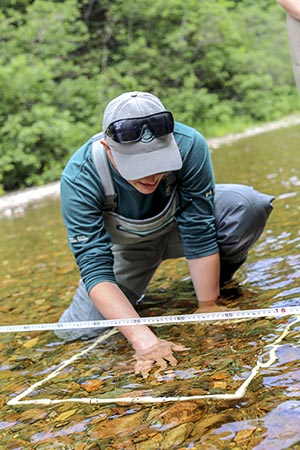
2.7 Project implementation and follow-up
Once an IA is approved with a determination that there are no significant adverse environmental effects, project authorizations and associated permits for implementing the project can be issued. Parks Canada will integrate conditions of approval (e.g. mitigation, surveillance and follow-up monitoring requirements) into project authorizations and permits.
- If a follow-up monitoring program is required, the duration of the monitoring program and any reporting requirements regarding the results of the program will be specified in project authorization documents and permits.
- Parks Canada may require or conduct surveillance Footnote 12 of the project throughout its implementation, to confirm work is being carried out in accordance with the conditions specified in the IA and associated project authorizations and permits. Surveillance results will be documented, and the Field Unit Superintendent may require corrective action be undertaken if surveillance results indicate the project is not being conducted in accordance with specified requirements.
3.0 Additional considerations
3.1 Indigenous engagement and consultation
Parks Canada views Indigenous relationships as partnerships, Footnote 13 reflecting both our obligations related to legal and policy documents and our commitment to reconciliation. As a result, Indigenous engagement and consultation must be additional to, and separate from, other public engagement. The participation of Indigenous peoples in the impact assessment process will respect and reflect their rights and interests, and Indigenous knowledge provided through the process will be taken into account. Note that Parks Canada may undertake consultations with Indigenous peoples separate and apart from the engagement or consultation conducted as part of the IA if there is a likelihood of a project adversely affecting established or potential Aboriginal or Treaty rights protected by Section 35 of the Constitution Act, 1982. Proponents must seek direction from the Parks Canada Impact Assessment Practitioner before initiating Indigenous engagement and consultation activities.
3.2 Public and stakeholder engagement
Parks Canada’s IA processes will be transparent, providing opportunities for important insights, information and values of the public and stakeholders to influence the assessment. Public and stakeholders will be notified of IA processes, documents will be made available and rationale for decisions will be provided in a manner that is consistent with the Parks Canada designated IA pathway. Notice of Parks Canada BIAs and DIAs are posted on the Canadian Impact Assessment Registry for a minimum of 30 days. Footnote 14
Some project proposals warrant public and stakeholder opportunities for engagement that exceed that offered by the public registry. These may be projects with a history or likelihood of public interest, with a perceived potential for having significant adverse environmental effects, or where there may be opportunities for local knowledge held in the community. The need, format, scope and timing of additional engagement activities is at the discretion of the Field Unit Superintendent. All comments received from the public and stakeholders are to be provided to Parks Canada and evidence of how these comments influenced the assessment must be included in the assessment report.

3.3 Species at Risk Act considerations
Species at risk are found in many protected heritage areas. Both the Species at Risk Act (SARA) and the Impact Assessment Act (IAA) require consideration of the potential effects of proposed activities on a species at risk, its residence and critical habitat Footnote 15. In addition, in certain circumstances, an authorization under SARA may be required. Parks Canada Impact Assessment Practitioners and Species Conservation specialists are available to provide advice to project proponents regarding species at risk requirements.
3.4 Additional legislative requirements
The following legislative requirements, which fall outside the authority of Parks Canada, may affect project scheduling and should be taken into consideration early in the project planning process.
- When work is proposed in or around water, specific provisions of the Fisheries Act may apply to the project. It is the proponent’s responsibility to understand and address the requirements of the Fisheries Act, including determining whether there is a need to obtain advice on potential effects from the Fisheries and Oceans Canada (DFO) and the requirement for obtaining any authorization from DFO. Prior to approving an IA, it must be clearly demonstrated that the IA adequately meets Fisheries Act requirements.
- An approval from Transport Canada may be required for work in a waterway listed in the schedule of the Canadian Navigable Waters Act.
- Requirements under the Migratory Birds Convention Act, 1994 may also affect project timing, as the Migratory Birds Regulations prohibit the disturbance or destruction of nests and eggs of migratory birds. It is therefore important to identify nesting timing windows, particularly if the project includes the removal of vegetation that provides nesting habitat.
Additional information regarding these requirements can be found from the responsible federal departments.
3.5 UNESCO World Heritage Sites
Parks Canada manages several UNESCO World Heritage Sites, including natural World Heritage Sites such as Nahanni National Park Reserve and Gros Morne National Park, and cultural World Heritage Sites such as the Rideau Canal (see the Parks Canada website for further information on Parks Canada World Heritage Sites). These sites are inscribed on the World Heritage List on the basis of the identified “Outstanding Universal Value” (OUV) of the site, which reflects the characteristics that contribute to the site’s international significance. For projects that may affect a Parks Canada-administered World Heritage Site, any potential effects on the OUV of the site must be considered during the impact assessment.

3.6 Working with other federal authorities
In some instances, there may be multiple federal authorities with an obligation to ensure that a project is not likely to cause significant adverse environmental effects on federal lands under Section 82 of the IAA. In this situation, during project planning discussions, project proponents must ensure all federal authorities involved in the project review are aware of Parks Canada’s IA process and legal and mandate requirements. A lead federal authority may be selected to coordinate the review of the IA of the project. Parks Canada may perform this federal coordination role, or for larger projects that extend outside of Parks Canada’s lands, the lead may fall to another federal authority. In this scenario, each federal authority retains the responsibility to make a determination on the likelihood of significant adverse environmental effects pursuant to Section 82 of the IAA.
For any project requiring federal coordination, Parks Canada will conduct its own review of IA documents and make a determination with regard to the significance of effects on Parks Canada lands. In keeping with its legal and mandated priorities, Parks Canada must ensure the IA and mitigations address potential effects on natural and cultural resources. Approval of the final IA by the Field Unit Superintendent will be required.
3.7 Changes to a previously assessed project
If a proponent proposes changes to a project for which an IA has already been conducted or there is new information regarding the potential impacts of a project for which an IA has already been conducted, the existing IA may still be used, provided any project elements that were not previously assessed are added as an addendum and submitted for approval by the Field Unit Superintendent. The addendum should include:
- a brief description of proposed changes;
- a list of additional environmental and residual effects;
- required mitigations;
- space for Parks Canada to make an updated determination of significance; and,
- a signature block for approval by the Field Unit Superintendent.
Changes to a project may require a corresponding change to the Canadian Impact Assessment Registry and possibly a re-start of the 30 day public notification period prior to IA determination. Proponents must consult with Parks Canada when making changes to the project description, environmental setting, scheduling, or any other factor that may influence the IA.
The use of an addendum may not always be appropriate, depending on the scope of the proposed changes. The Field Unit Superintendent will decide whether the use of an addendum is reasonable for a specific project.
4.0 Tools and resources
Parks Canada has a number of tools and reference materials for external proponents, the public, stakeholders, and Indigenous peoples who may participate in a Parks Canada IA process. These can be obtained through the Parks Canada Impact Assessment Practitioner at the relevant protected heritage place. For assistance in finding an appropriate contact, email Parks Canada at: pc.evaluationsenvironnementale environmentalassessment.pc@canada.ca.
Appendix 1 – Guidance for the application of the Detailed Impact Assessment (DIA) pathway
The following criteria are intended to guide the Field Unit Superintendent in considering whether a proposed project should be required to undergo a DIA. The list indicates the types of projects and potential adverse effects that may warrant a DIA; however, it is recognized that each decision will be based on a range of project and site-specific considerations.
- Projects involving expansion of community growth limits or boundaries, new or expanded leasehold or license of occupation boundaries, or other important changes to land use tenures or agreements that are not consistent with or approved in existing community plans.
- Projects involving expansion of regional or community power supply, rights-of-way, power-lines, submarine cables, pipelines or other regional utilities infrastructure.
- Projects involving small commercial renewable energy generation project or distribution operations in an NMCA.
- Plans or projects for new development, expansion, or substantive changes in use associated with resorts and accommodation, campgrounds, golf courses, ski areas, waterfronts and marinas, and other outdoor recreation facilities.
- Projects likely to result in the substantive alteration of water level, flow or management regime in a water body, or result in other important changes to surface or groundwater resources.
- Projects involving new or expanded roads, including operational service or access roads or crossing structures.
- Projects involving new or alterations to an aquaculture site in a NMCA.
- Projects involving commercial harvest of aquatic vegetation.
- Projects involving the permanent and substantive modification or reconfiguration of terrain within alpine, riparian, wetland or aquatic environments, in unstable terrain or other sensitive environments.
- Projects likely to alter ecological composition, structure or process resulting in the impairment of ecosystem function.
- Projects likely to threaten the continued persistence of a native species population, either directly or through the alteration of habitat.
- Projects involving the reintroduction of a species.
- Projects likely to adversely affect ecological or natural values or the sustainability of environmental resources of another jurisdiction.
- Projects likely to change the nature and experience of unique, iconic or otherwise valued components characteristic of wilderness, the natural environment, or the historical and cultural significance of a protected heritage place.
- Removing or destroying cultural resources on a national historic site that would have impact on the national historic site designation or regionally important cultural resource in a national park or national marine conservation area.
- Projects likely to have high adverse effects on values of importance to Indigenous groups or identified by cooperative management structures, and values critical to the exercise of Aboriginal or Treaty rights protected under Section 35.
- Projects likely to result in significant interest or controversy among members of the public, stakeholder or Indigenous peoples related to potential adverse effects on natural or cultural resources, or components of the environment critical to key visitor experience objectives.
- Date modified :